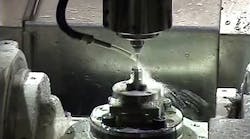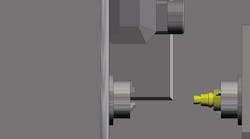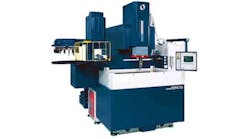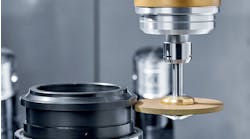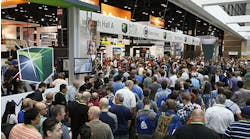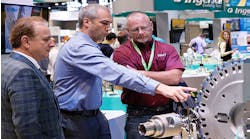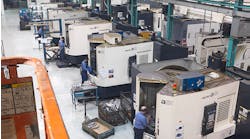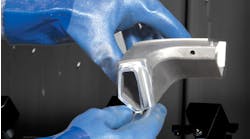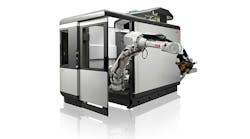Electrical discharge machining (EDM) will always seem like a magical process, as masses of solid material seem to detach silently from a raw workpiece and the profile of a finished or semifinished design is revealed. EDM (both the die-sinking EDM and wire EDM options) are the focus of as much technical revision and improvement as any other single machining technology – but what is more distinctive are the new applications and expectations that manufacturers derive for the EDM processes.
For example, the emergence of additive manufacturing technologies in the past half decade initiated a wave of new interest in EDM systems that could be used to quickly prepare a clean surface to which AM could apply very specific details. Dies and molds could be finished this way, as could surgical devices and medical implants.
In the build up to September’s International Manufacturing Technology Show in Chicago, EDM is being linked to the factors driving new investment in U.S. manufacturing operations, a trend characterized as ‘reshoring’ of capabilities once settled overseas. “Some experts see a re-shoring trend due to the increasing demand for micro components produced by high precision EDM technology,” IMTS sources reported recently.
“The American machinist has higher expectations for quality, accuracy and productivity, and that attracts customers to the U.S. market,” stated Gisbert Ledvon, director of business development, GF Machining Solutions, one of the foremost developers and suppliers of EDM systems. At the upcoming event, GF Machining will introduce its AgieCharmilles CUT 2000 X advanced wire EDM system: this machine reportedly eliminates pitch and positioning errors that frequently result in scrapped parts and higher production costs, and its precise positioning capabilities allow it hold very tight part tolerances and thus achieve exceptional quality and surface finish.
”To find EDM technology that enables a machine shop to differentiate itself, I can think of no better place than IMTS — The International Manufacturing Technology Show,” Ledvon added. “IMTS provides the perfect overview because a machine shop owner can evaluate the entire spectrum of EDM technology in one location.
“That said, I don’t think shop owners want to be mainstream anymore,” he continued. “They want high-end EDM technology and seek customers that challenge them to deliver innovative solutions, such as 1-micron accuracy.”
EDM advances on display — “If you think of EDM as a mature technology, think again. IMTS 2016 will expose you to new machines capable of greater accuracy and enhanced surface finishes,” emphasized Peter R. Eelman, v.p., Exhibitions & Business Development for AMT - the Association for Manufacturing Technology. “We’re especially gratified to see the incorporation of the MTConnect communications protocol in EDM machines being demonstrated at the show.”
(MTConnect, the open protocol for machine-performance data sharing and reporting had its debute at IMTS in 2008, and since then has become an industry standard for networked operations – with much support by AMT.)
Protocols likes MTConnect promote faster and better communication between devices and software controls. The ability to monitor and analyze more data has real benefits, e.g., 1-micron accuracy. By placing advanced temperature sensors in a workpiece, the dielectric and the work zone and connecting them to CNC controls, EDM machines can maintain the part at a consistent temperature (68° F / 20° C) at which dimensions are measured. Eliminating the variables related to thermal expansion or contraction means that an EDM machine can cut with greater accuracy and repeatability.
Other EDM advances to be presented at IMTS 2016 will include in-process inspection systems that perform pre-setting, in-process measurements and scanning of the contour machined, all of which increase efficiency and accuracy.
Another Dimension of Improvement
Another development with in EDM has new machines offering automatic wire threading capability. These machines make a first cut faster, with larger diameter wire (e.g., 0.01 inch), and then switch automatically to a smaller wire diameter (e.g., 0.004 inch or finer) for complex parts.
“Users can now purchase a single machine that runs unattended instead of one machine for a coarser cut and a second machine for a finer cut,” said Ledvon. “Operators are free to attend to other tasks, don’t have to transfer parts between machines and don’t have to worry about accuracy errors related to cutting on two different machines.”
Vision systems are adding another dimension of improvement to EDM. The newest vision capabilities are being incorporated into EDM machining processes, again to increase the quality of the finished products. Vision technology is used to compare the shape of the contour just cut with a 3D model of the part: If the system senses any deviation from the desired dimensions, it will make any adjustments to the next part automatically.
“The current generation of wire EDM machines basically incorporate smart machine capabilities,” according to Ledvon. “In-process inspection eliminates one step of the quality assurance process while minimizing scrap or rework.”
There are different advantages to the two types of EDM technology: Die sinking EDM is particularly useful in mold machining, which is a sector where cost and volume of production can have significant marginal effects. “End users are now asking for enhanced surface finishes that enable them to make millions of plastic parts without maintenance on the mold,” Ledvon explained. “We can accomplish this not by changing the RA [roughness] value, but by changing the shape of the surface texture.” In practice, this means that finished molded parts can be removed more quickly and reliably from the mold.
Next-Gen EDM — With advanced touchscreen controls that differentiate it from more established milling machine designs, sophisticated EDM systems can attract the interest of people new to manufacturing and interested in working with advanced equipment for a living. That’s a part of its ‘magic.’
“EDM enables near-perfect predictability and unmatched repeatability. Its higher level of automation sets young operators up for successful results, and that makes machining a more attractive career,” Ledvon observed.
“Today’s generation does not want to use yesterday’s technology,” according to Eelman. “Whether you’re evaluating career options, a shop owner looking to attract new customers or an industry representatives looking for greater value, you can find answers in the EDM pavilion,” at IMTS 2016.

